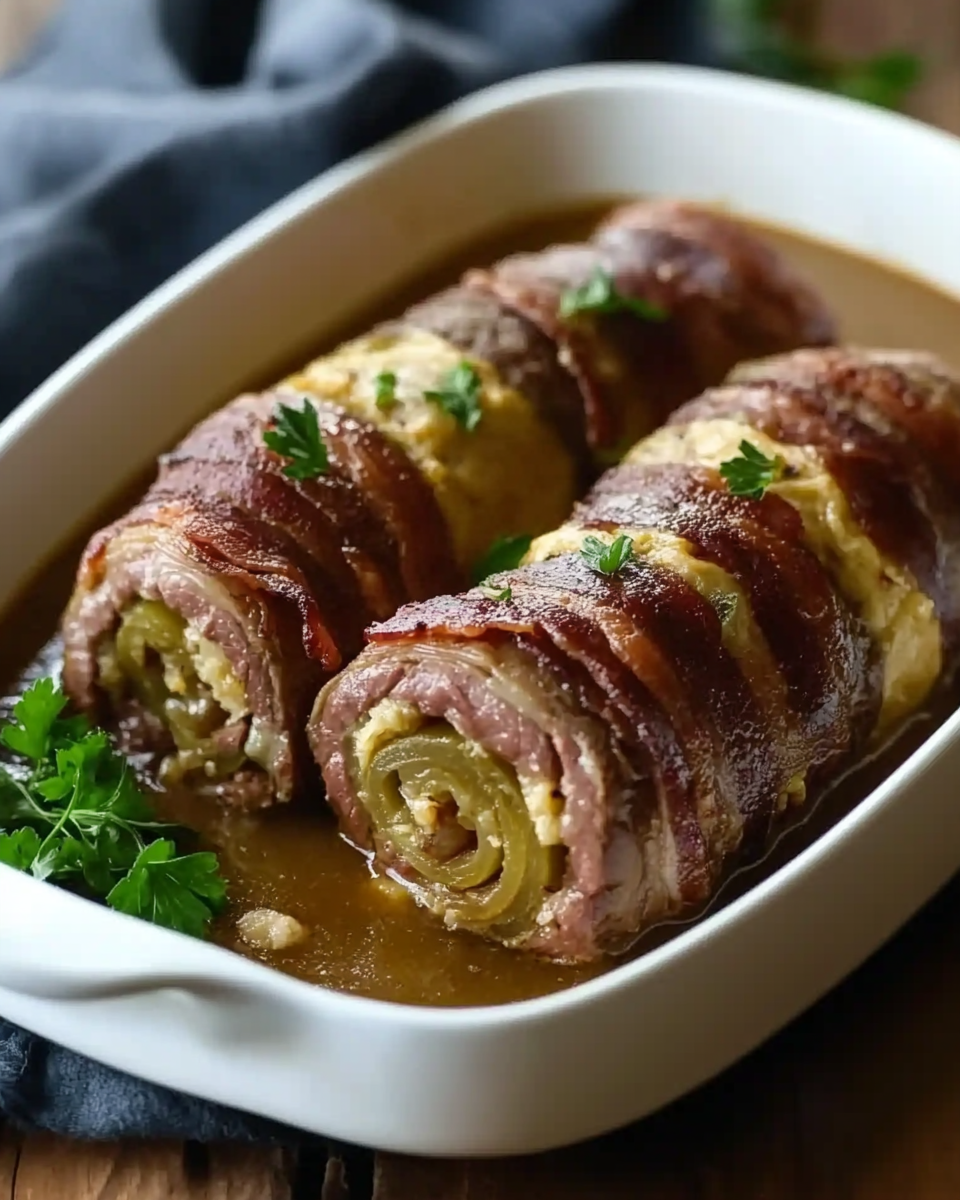German Rouladen is a delicious and classic dish made of thin slices of beef rolled with mustard, bacon, onions, and pickles, slow-cooked in a rich gravy. This hearty dish is perfect for family gatherings or special occasions and provides a comforting, savory meal with a satisfying combination of flavors. The tender beef soaked in a flavorful gravy is complemented by the crispy bacon and tangy pickles, making it a crowd-pleaser every time!
Full Recipe:
Ingredients
For the Rouladen:
- 4 large slices of beef top round or flank steak (about ¼ inch thick)
- 4 tablespoons German mustard
- 4 slices bacon
- 1 onion, thinly sliced
- 4 small pickles (dill or gherkins), sliced lengthwise
- 2 tablespoons olive oil
- 2 cups beef broth
- ½ cup red wine (optional)
- 2 tablespoons all-purpose flour
- 2 tablespoons butter
- Salt and pepper, to taste
- Fresh parsley, chopped (for garnish)
Directions
- Prepare the Beef:
Lay the slices of beef on a clean surface. Spread each slice with 1 tablespoon of mustard. Layer a slice of bacon, some onion slices, and pickle slices on top of the mustard. - Roll and Secure:
Roll up each slice of beef tightly and secure the ends with toothpicks or kitchen twine to keep the fillings inside. - Brown the Rouladen:
In a large pot or Dutch oven, heat the olive oil over medium-high heat. Add the roulades and brown on all sides. Remove the roulades and set them aside. - Make the Gravy:
In the same pot, add butter and flour, whisking constantly to create a roux. Slowly add the beef broth and red wine (if using), whisking until smooth. Bring to a simmer. - Simmer the Rouladen:
Return the roulades to the pot, cover, and reduce heat to low. Simmer gently for 1.5 hours, or until the beef is tender. - Serve:
Remove the toothpicks or twine from the roulades. Serve hot, garnished with fresh parsley, and with a side of Rotkohl (braised red cabbage), Spätzle (egg noodles), or Kartoffelklöße (potato dumplings).
Nutrients (Per Serving)
- Calories: 350 kcal
- Carbohydrates: 8g
- Sugar: 2g
- Fat: 20g
- Saturated Fat: 7g
- Protein: 30g
- Sodium: 550mg
- Cholesterol: 85mg
- Fiber: 2g
- Sugar: 2g
- Iron: 3mg
The History and Tradition of Rouladen
Rouladen has deep roots in German cuisine, with its origins dating back to the 18th century. It is a dish that reflects the German love for hearty, flavorful meals. Traditionally, it was made with leftover beef or tougher cuts of meat, which were slow-cooked to tender perfection. Over time, it became a staple of German home cooking, often reserved for special occasions, family gatherings, and holiday meals.
In its traditional form, Rouladen is not just a main course; it’s a dish meant to bring people together. The process of rolling the beef and cooking it slowly allows the flavors to meld together, creating a dish that’s as much about the preparation as it is about the enjoyment of a shared meal. In Germany, Rouladen is commonly served with side dishes like Rotkohl (braised red cabbage), Spätzle (egg noodles), or Kartoffelklöße (potato dumplings), which help soak up the rich gravy.
The Components of German Rouladen: A Symphony of Flavors
What makes German Rouladen so unique is the combination of savory, tangy, and umami flavors in each bite. The thin slices of beef are the star of the dish, and their richness is balanced by the other ingredients inside the roulades.
-
Mustard: The traditional German mustard used in Rouladen is sharp and tangy, providing a zesty base layer of flavor. The mustard also helps tenderize the meat slightly, allowing it to absorb more of the other flavors as it cooks.
-
Bacon: Bacon is a key ingredient in many German dishes, and Rouladen is no exception. The smoky, savory bacon adds richness to the otherwise lean beef, enhancing the overall flavor profile of the dish. When cooked, the bacon crisps up and releases its fat, which adds a deeper flavor to the gravy.
-
Pickles: Slices of dill or gherkin pickles are placed inside the beef rolls, contributing a tangy, slightly sour note that cuts through the richness of the meat and bacon. The pickles also provide a nice crunch, contrasting with the tender beef.
-
Onions: Onions are finely sliced and added to the roulades for a touch of sweetness and depth. When slow-cooked in the gravy, the onions soften and release their natural sugars, enhancing the overall flavor of the dish.
-
Gravy: The rich gravy, made from the beef broth, red wine (optional), butter, and flour, ties the entire dish together. The roux created with butter and flour thickens the gravy, making it a flavorful accompaniment to the beef and its fillings.
The Slow-Cooking Process: Unlocking Tenderness and Flavor
The magic of Rouladen lies in the slow-cooking process. After the roulades are browned in a Dutch oven, they are simmered in a mixture of beef broth and wine (if used) for about 1.5 hours. This slow simmering allows the beef to absorb the flavors of the broth and the seasonings, resulting in meat that is incredibly tender. The gravy thickens as the roulades cook, becoming a rich, flavorful sauce that enhances every bite of the beef.
The process is simple but takes time. The key to a great Rouladen is the patience to allow the meat to braise properly, ensuring that it becomes tender enough to melt in your mouth. The result is a savory, melt-in-your-mouth dish that is rich in flavor and incredibly satisfying.
The Ideal Pairings for German Rouladen
German Rouladen is traditionally served with hearty, flavorful side dishes that complement the richness of the meat and gravy. Some of the most popular sides include:
-
Rotkohl (Braised Red Cabbage): The sweetness of braised red cabbage pairs perfectly with the savory, tangy flavor of the Rouladen. The cabbage’s tartness helps cut through the richness of the beef and gravy, balancing the flavors on your plate.
-
Spätzle (Egg Noodles): These soft, pillowy noodles are perfect for soaking up the gravy from the Rouladen. Spätzle has a light texture that contrasts with the dense, hearty beef, making it an ideal accompaniment.
-
Kartoffelklöße (Potato Dumplings): These soft, fluffy dumplings are another classic side dish for Rouladen. They absorb the rich gravy and provide a comforting contrast to the tender beef.
In addition to these classic sides, Rouladen can also be served with simple roasted potatoes, mashed potatoes, or a side salad for a lighter meal.
Why German Rouladen Is Perfect for Special Occasions
German Rouladen is a dish that requires a bit of time and effort, but the results are well worth it. The preparation and cooking process makes it a great option for special occasions, family gatherings, or holiday dinners. The dish is impressive enough to serve to guests but simple enough to make at home for a cozy dinner.
The rich flavors of the braised beef, combined with the tangy mustard, smoky bacon, and crunchy pickles, create a unique and satisfying flavor profile that will leave everyone at the table asking for more. The versatility of the dish also allows it to be paired with a variety of sides, making it an excellent option for accommodating different tastes and dietary preferences.
Conclusion: A Hearty, Flavorful Dish for Any Occasion
German Rouladen is a classic, comforting dish that combines tender beef, savory bacon, tangy pickles, and rich gravy. Its slow-cooked, melt-in-your-mouth texture and bold, balanced flavors make it the perfect meal for family gatherings, holidays, or any special occasion. While it takes some time to prepare and cook, the result is a dish that will impress your guests and satisfy your cravings for hearty, flavorful food.
With its combination of flavors and textures, Rouladen is a dish that brings people together. It’s the kind of meal that feels like a warm embrace, offering comfort and satisfaction with every bite. Whether you’re making it for a special celebration or a simple family dinner, German Rouladen is sure to become a favorite in your recipe repertoire.

